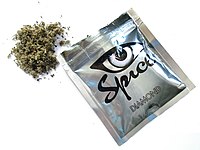
Photo from wikipedia
The present study focused on 11-nor-9carboxy-Δ9-THC (THC-COOH) and Benzoylecgonine (BE), the most common metabolites of cannabis and cocaine, respectively, present in the domestic sewage entering the wastewater treatment plants. The… Click to show full abstract
The present study focused on 11-nor-9carboxy-Δ9-THC (THC-COOH) and Benzoylecgonine (BE), the most common metabolites of cannabis and cocaine, respectively, present in the domestic sewage entering the wastewater treatment plants. The aims of the study were: (1) to validate the analytical method of detection in wastewater and sludge; (2) to determine contribution of biodegradation and other processes to the removal in the biological reactor of the wastewater treatment plant (WWTP) and the response of biomass to different drug concentrations. The Ultra-Performance Liquid Chromatography coupled to tandem Mass Spectrometry method showed to be repeatable and reliable (recovery>75%; repeatability<10-15%; bias uncertainty<10) for measurements in wastewater; the ultrasound assisted extraction (USE) demonstrated to be reliable as pre-treatment of activated sludge solid phase. Both drugs were fully removed from the liquid phase in the lab-scale biological reactor within 24 h. Biodegradation was the main BE removal mechanism, and the first order kinetic model provided the best fitting of the experimental data. THC-COOH was mainly removed due to a combination of adsorption and biodegradation; adsorption was better described by the pseudo-second order kinetic model and the Freundlich isotherm. Both drugs at the higher concentrations caused inhibition of nitrogen oxidation and carbon removal.
Journal Title: Chemosphere
Year Published: 2019
Link to full text (if available)
Share on Social Media: Sign Up to like & get
recommendations!